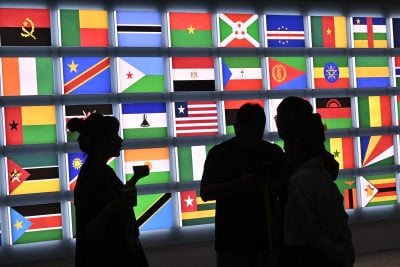Although Africa was far from the epicentre of the Covid-19 pandemic and has recorded some of the lowest casualty rates, the region has been disproportionately affected by the socioeconomic fallout from the crisis.
Despite the strong rebound in 2021, Africa’s per capital income is not likely to return to pre-pandemic trend growth anytime soon, and nor are the poverty rates, which have increased sharply.
This reflects, in part, the fact that the region remains commodity-dependent and was hit hard by the first-round effects of the crisis when containment measures led to a global demand shock and collapse in commodity prices, with oil prices falling to historical lows.
The African Continental Free Trade Area (AfCFTA), which entered into force a year ago with the commencement of trading under the agreement on January 1 2021, is expected to accelerate the diversification of sources of growth and trade to flatten the unhealthy correlation between growth and commodity price cycles.
The first consignment of goods traded under the AfCFTA – from Ghana to South Africa – were manufactured goods. Unlike extra-African trade, which primary commodities and natural resources dominate, intra-African trade is driven largely by manufactured goods.
Such activity could catalyse industrialisation as corporates capitalise on economies of scale associated with the single market and incentives associated with the rules of origin underpinning the landmark continental trade agreement.
The AfCFTA – which connects more than 1.3bn people across 55 countries, with a combined GDP of $3.4 trillion – has been touted as a globalisation game-changer. It has the power to defragment Africa, removing the physically invisible and yet very real barriers to cross-border trade flows that have segmented regional markets and made it difficult for companies to spread the risk of investing in smaller economies.
It will increase investment flows and shift their composition and direction away from natural resources towards labour-intensive manufacturing industries.
Moreover, it has the potential to transform African economies and significantly raise the continent’s share of global trade while strengthening its bargaining power in international trade negotiations.
Encouraging signs
For all these reasons, the agreement has attracted a great deal of attention in academic and policy circles, as well as within the international development community, including the World Bank (The AfCFTA: Economic and Distributional Effects), International Monetary Fund (The AfCFTA: Potential Economic Impact And Challenges), United Nations Conference on Trade and Development (Economic Development in Africa: Made in Africa – rules of origin for enhanced intra-African trade) and African Export–Import Bank (Boosting intra-African trade: Implications of the AfCFTA Agreement). On the occasion of the agreement’s inaugural anniversary, the Journal of African Trade released the first-ever special issue on “The AfCFTA and African Trade” that I co-edited with Andrew Mold.
What all the research studies and reports have in common is the consistency of empirical results, all pointing to the agreement’s significant and positive development impact.
Specifically, the results according to computable general equilibrium models are deeply encouraging. Aggregate headline estimates derived from these models show that employment and the average GDP of the region would both increase by 0.5% annually after full implementation of the AfCFTA.
Real wages would increase across the board for both skilled and unskilled workers, with the latter registering a much higher growth rate in an apparent shift towards more inclusive growth. The World Bank estimates that the gains accrued from the AfCFTA’s implementation could lift 30m people out of extreme poverty and around 68m out of moderate poverty, with women benefiting more than men in a more gender-sensitive growth model.
The potential impact at the household and corporate levels are also significant, with estimates showing that, by 2030, the fully integrated market of $1.7bn people will have an estimated $6.7tn of combined consumer and business spending.
Trade within Africa is expected to enjoy the most impressive rate of expansion under the agreement, with intraregional exports increasing by 34% (equivalent to around $133bn annually) compared to a scenario without the AfCFTA. Around two-thirds of intra-African trade gains would be realised in the manufacturing sector.
This would set the stage for a welfare-enhancing and mutually reinforcing relationship between intraregional trade and industrialisation, which over the years has provided the path to sustainable growth of well-paying manufacturing jobs while simultaneously broadening the tax base and improving external accounts to improve macroeconomic stability.
Obstacles to overcome
These empirical results are consistent with economic theory. Allocation efficiency and accumulation effects associated with regional integration are expected to boost productivity and fuel economic growth. At the same time, economies of scale associated with trade integration reduce uncertainty in intraregional trade and accelerate the rate of technological changes to drive structural transformation.
In practice, trade integration has been a vector of spectacular success, the case in point being Asia, where the rapid expansion of regional value chains has not only deepened integration but accelerated structural transformation for effective integration into global value chains, sustaining high rates of economic growth.
But trade liberalisation alone does not necessarily guarantee economic success. Substantial non-tariff barriers, regulatory differences and divergent sanitary, phytosanitary and technical standards raise the costs of cross-border trade. Across Africa, these costs are estimated to be 14.3%, largely above the average tariffs of 6.9%.
Lifting these constraints will significantly boost intra-African trade and drive growth. The World Bank estimates that the real income gains from a full implementation of the AfCFTA could increase by 7% (or around $450bn) by 2035, with trade facilitation measures that cut red tape and simplify customs procedures alone providing a $292bn increase.
Overcoming the chronic infrastructure deficit – both physical and digital – will boost the power of trade creation to ensure a successful implementation of the AfCFTA. Africa’s infrastructure deficit is at the intersection of the continent’s supply-side constraints in both the production space, most notably through productivity enhancement and output expansion, and logistics, through the delivery of goods and services within and between countries in a region that has the largest number of landlocked countries (16) in the world.
As investors look to capitalise on economies of scale offered by the AfCFTA to raise productivity and sustain balance sheet growth, nothing is as pressing as integrating markets and improving connectivity.
Furthermore, ironing out the rules of origin – the passport that determines if products are duty-free under the AfCFTA – is also key. These will act as an accelerator of industrialisation and the development of regional value chains to deepen integration.
Significant progress has been made on the rules of origin agreement, which should be concluded later this year to pave the way for phase-two negotiations on key issues that will shape the drivers of growth, including protocols on investment, competition policy and intellectual property rights.
Making Africa a global player
At the same time, prioritising the collective interest is perhaps Africa’s most important and perennial challenge on the long road to integration, as has been so well illustrated by the rush to bilateral trade deals.
Although the AfCFTA does not prevent member countries from entering into bilateral trade negotiations with third-party nations, doing so could affect regional trade patterns and set precedents for regional trade and investment rules. Such deals could lead to trade deflection, given that the AfCFTA’s most-favoured-nation clause automatically extends tariff concessions granted to a third party to AfCFTA members.
With the coming into force last year of the AfCFTA, dozens of countries – 40 of 54 signatories have ratified the agreement at time of writing – immediately undertook a linear reduction in their existing intra-African trade tariffs on 90% of tariff lines (the ultimate goal is 97% liberalisation).
Clarifying the rules of origin to strengthen the trade-industrialisation nexus and maximise opportunities for value addition will further increase the development impact of the reform, accelerating the diversification of sources of growth to mitigate countries’ exposure to recurrent adverse commodity terms of trade shocks and positioning the region as a global player.
To quote Jeffrey Sachs, “Without doubt, if Africa becomes economically integrated, it will be a global player and the largest economic region in the world.” But for the AfCFTA to become the launch pad for Africa’s deeper integration into the world economy as a proactive force of change, it is crucial to complement trade liberalisation with robust trade facilitation measures, as well as strengthen regional coordination mechanisms by engaging external partners as a unified trading bloc.
Want to continue reading? Subscribe today.
You've read all your free articles for this month! Subscribe now to enjoy full access to our content.
Digital Monthly
£8.00 / month
Receive full unlimited access to our articles, opinions, podcasts and more.
Digital Yearly
£70.00 / year
Our best value offer - save £26 and gain access to all of our digital content for an entire year!
 Sign in with Google
Sign in with Google 



